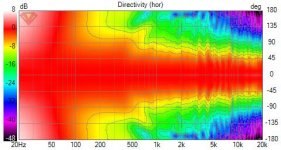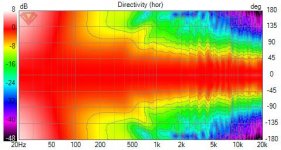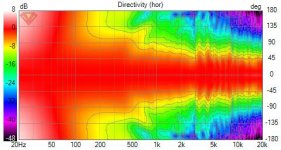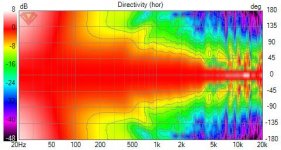wouldn't work out too well, 2kHz as ~17cm long would dictate ~4cm diameter coaxial woofer with tweeter on the middle 😀 Even at 1kHz this is ~8cm, almost impossible to find such driver.... same idea applied to a coaxial driver would require woofer diameter 1/4wl at crossover frequency, for "true point source". Perhaps this is not too important.
I'm not sure am a following your thoughts. As far as I understand the coaxial sources grades from a small dome to concentric dome+cone and finally to cone (a ring) around the crossover. The outer radius of the R series driver is 46-47mm. And if the driver is placed in a waveguide, we should consider the coupling to waveguide modes. All in all quite different that two separate point sources or cones at a distance of lambda/4.
The acoustic center of a ring source is the center of the ring, right?
The acoustic center of a ring source is the center of the ring, right?
It is the shape and height of the surround that I think might cause less of an impact the way they have done it, an inverted dome for the cone being a lesser effect.Based on my simulations, slightly shallower woofers make hardy any impact on the vertical response.
^^ I'm thinking the woofer cone is big enough that at ~2kHz the response is already narrowing before tweeter takes over. Diameter of 12cm is 1/2wl of roughly 1.5kHz, which means some destructive interference to the sides. This is seen on the woofer measurements but it is nothing too dramatic system level, your DI and power don't show issues here. Just an academic thought experiment thinking point sources. They are still acoustically co-incident the woofer and tweeter, that is the important thing.
Anyway, tried to catch up your resent posts and a lot progress there. Thanks for posting all the progress, very informative!
Anyway, tried to catch up your resent posts and a lot progress there. Thanks for posting all the progress, very informative!
Last edited:
^^ I'm thinking the woofer cone is big enough that at ~2kHz the response is already narrowing before tweeter takes over. Diameter of 12cm is 1/2wl of roughly 1.5kHz, which means some destructive interference to the sides. This is seen on the woofer measurements but it is nothing too dramatic system level, your DI and power don't show issues here. Just an academic thought experiment thinking point sources. They are still acoustically co-incident the woofer and tweeter, that is the important thing.
Anyway, tried to catch up your resent posts and a lot progress there. Thanks for posting all the progress, very informative!
Thank you, I appreciate your comments. I obviously missed the beaming point. Here are the horizontal polars brickwalled at 2000, 2500, and 3000Hz. The directivity mismatch doesn't really start to appear before 3kHz, and the mid starts beaming above 3.5 kHz.
Attachments
Yeah no problems system level, as you said influence of the baffle and influence of the cone to the tweeter response makes it work nicely as system and if there was problem it would show up here.
I tend to think and write simultaneously and this was unnecessary thought experiment to post in this context, but I guess as long as discussion is somewhat related there is chance to pick up ideas and clarify thoughts if nothing else, even if the message itself wasn't anything meaningful at the time.
Thanks for the thanks, keep up good work!🙂
I tend to think and write simultaneously and this was unnecessary thought experiment to post in this context, but I guess as long as discussion is somewhat related there is chance to pick up ideas and clarify thoughts if nothing else, even if the message itself wasn't anything meaningful at the time.
Thanks for the thanks, keep up good work!🙂
No worries. It is relevant. It's so easy get fixated on some particular tree that it's a nice to have others remind that there's other trees as well and sometimes it would be good to take a look at the forest too🙂
I think this is one of the rare discussion boards where I can honestly say that all comments are welcome.
I think this is one of the rare discussion boards where I can honestly say that all comments are welcome.
What kind of amplifiers will you use?Started sketching the XO with some PEQs and LR4 at 250 Hz and 2.2 kHz. The low frequency accuracy is what it is with 4.3 ms time window but all in all this doesn't look too bad. Actually pretty good in for the horizontal direction as expected from the individual driver data. This could certainly be still improved with the existing measurement data, but I think I will see if I could repeat the measurements in a larger room to get a bit better data for the low range. The second picture shows how much smoother the DI response is if the vertical data is excluded. This is of course true for many speakers, so something to keep in mind when comparing different data.
I should also admit that I pulled the trigger for a pair of 1753 drivers🙂
I would recommend tweaking the performance of power response, as you can see in the picture above, it makes sense for me and this will help improve the treble brillance. Have there been any listening tests yet?
Can you please post raw 0° responses of drivers?
Otherwise great job on the box! 🙂
I have a two 1-channel TPA3255 boards for the woofers and two 2-channel TPA3255 boards for the mids and tweeters, all from 3e Audio.What kind of amplifiers will you use?
View attachment 1054591
I would recommend tweaking the performance of power response, as you can see in the picture above, it makes sense for me and this will help improve the treble brillance. Have there been any listening tests yet?
Can you please post raw 0° responses of drivers?
Otherwise great job on the box! 🙂
I will probably not do any finetuning or listening tests before I get to install and measure the 1753 drivers, which have not arrived yet. But thank you for the tip. I'll make a note next to fluid's recommendation of slightly tilted listening window response.
Here are the axial responses of the individual drivers in the box. The woofer response is merged from the nearfield and farfield measurements using baffle diffraction correction in vituixcad.
Thanks for answers.
Ok so now you have installed only test KEF drivers and you're waiting for SP1753? And which drivers do you use for measurements?
Amps with TPA3255 looks good. What I really like is size and weight. I'm thinking about upgrade of my 6ch amplifier to something smaller, becouse when I need to move my 6ch amp, it's little bit heavy. 🙂
The dip at 1400 Hz at midrange is due to baffle?
Gain at amps is same for all 3 ways (do you compensate baffle step)?
Maybe it not bad to sum NF of midrange (I don't know where it's resonance frequency).
M.
Ok so now you have installed only test KEF drivers and you're waiting for SP1753? And which drivers do you use for measurements?
Amps with TPA3255 looks good. What I really like is size and weight. I'm thinking about upgrade of my 6ch amplifier to something smaller, becouse when I need to move my 6ch amp, it's little bit heavy. 🙂
The dip at 1400 Hz at midrange is due to baffle?
Gain at amps is same for all 3 ways (do you compensate baffle step)?
Maybe it not bad to sum NF of midrange (I don't know where it's resonance frequency).
M.
@Martin87, so far all measurement (and COMSOL simulations) are for the Q100 drivers which are to be replaced by SP1753 when they arrive. This driver has a resonance peak just above 1kHz which is evident from Zvu's data . I think in my case the peak in the mid range response just above 1kHz and fall after that is a combination of the resonance peak and the baffle response. This is how it looks with the vituix cad diffraction tool without any edge rounding. Let's see how this frequency range looks like with SP1753.

I measured each driver with the same amplifier channel one by one, so there's no gain effects in the data. I have not measured the gains of the boards, but the 1-channel and 2-channel versions should have the same voltage gain, the former just has more capacity in terms of current output. Eventually I will adjust the low end based on the room response or proper anechoic data (there's a chance I get to do the measurements in an anechoic chamber which is good down to 100 Hz). Looks like there's really no need for BSC since it's compensated by the peaking low end resulting from the enclosure alignment. The driver efficiencies will be balanced with the dsp gains of the channels. The low-end shelf for sub-100Hz boost is to be adjusted based on in-room measurement, it's likely heavily overestimated in the filter design above. Getting anechoic data for the 100-300 Hz range would help a lot here.
I measured each driver with the same amplifier channel one by one, so there's no gain effects in the data. I have not measured the gains of the boards, but the 1-channel and 2-channel versions should have the same voltage gain, the former just has more capacity in terms of current output. Eventually I will adjust the low end based on the room response or proper anechoic data (there's a chance I get to do the measurements in an anechoic chamber which is good down to 100 Hz). Looks like there's really no need for BSC since it's compensated by the peaking low end resulting from the enclosure alignment. The driver efficiencies will be balanced with the dsp gains of the channels. The low-end shelf for sub-100Hz boost is to be adjusted based on in-room measurement, it's likely heavily overestimated in the filter design above. Getting anechoic data for the 100-300 Hz range would help a lot here.
OK, I have googled diffrence between SP1587 (Q100 drivers) and SP1753. In my opinion is good idea upgrade to "more midrange drivers".
I have tried that it's better not to use coaxials in fullrange, to reduce the travel of midrange cone. After all, Erin measured the effect of the midbass cone
position relative to the tweeter here:

Where do you get SP1753 drivers? (it can be very interesting to compare with new META drivers 🙂 )
I thik that's really good choise to use closed box with EQ for woofers. Now I'm using SP1588.2 with one veteran 8" woofer (Tesla ARZ 668) in closed box with EQ and accuracy (speed) of bass together with coax is really impresive for me. I researched (IMHO), that is better to use 1st order slopes to xover bass and midrange (about 200 - 300 Hz).
I have tried that it's better not to use coaxials in fullrange, to reduce the travel of midrange cone. After all, Erin measured the effect of the midbass cone
position relative to the tweeter here:
Where do you get SP1753 drivers? (it can be very interesting to compare with new META drivers 🙂 )
I thik that's really good choise to use closed box with EQ for woofers. Now I'm using SP1588.2 with one veteran 8" woofer (Tesla ARZ 668) in closed box with EQ and accuracy (speed) of bass together with coax is really impresive for me. I researched (IMHO), that is better to use 1st order slopes to xover bass and midrange (about 200 - 300 Hz).
For SP1716 (Q950) with meausured T/S
Qms 10.325
Qes 0.576
Qts 0.546
the travel increases below ~90Hz. I guess stock Q950 has around 12L volume, which does not let the cone to travel much.
Qms 10.325
Qes 0.576
Qts 0.546
the travel increases below ~90Hz. I guess stock Q950 has around 12L volume, which does not let the cone to travel much.
OK, I have googled diffrence between SP1587 (Q100 drivers) and SP1753. In my opinion is good idea upgrade to "more midrange drivers".
I have tried that it's better not to use coaxials in fullrange, to reduce the travel of midrange cone. After all, Erin measured the effect of the midbass cone
position relative to the tweeter here:
View attachment 1058349
Where do you get SP1753 drivers? (it can be very interesting to compare with new META drivers 🙂 )
I thik that's really good choise to use closed box with EQ for woofers. Now I'm using SP1588.2 with one veteran 8" woofer (Tesla ARZ 668) in closed box with EQ and accuracy (speed) of bass together with coax is really impresive for me. I researched (IMHO), that is better to use 1st order slopes to xover bass and midrange (about 200 - 300 Hz).
All coax using the cone driver as waveguide benifits from highpassing them. True for Tannoy, Kef,... this ask for threeway approach.
Sp1753 (as well as other ref) can be found at Setelec.fr
Sealed have different rendering than bass reflex. Maybe be the less steep slope of 12db/octave is better to your ears as it complement better your room own behavior( it is to me as well as transient behavior ( qtc)). And sure LT open some opportunity to easily adapt the behavior with some clicks ( if you are ok with the limitation they bring too)...
1rst order filter have one advantage: they don't smear transient. But the price to pay is you need particularly well behaved drivers on wide range of freq. It might be an issue if you are looking for low end extension: not many subwoofers can play 'high freq' without issues ( breakup).
200/300hz seems a bit low for uniQ i looked at (sp 1753). I'm sure they can do it but it bet distortion skyrocket under 400hz.
My experience with Tannoy 8" ( 2046) is that 250hz is the lower limit to it imho and for my preference( if going lower in freq i heard what i identifyed as imd between both drivers at higher level).
It's all tradeoff and to adapt to situation ( driver/box/design criteria).
Does someone have T/S parameters of sp1753?
It seems you guys have convinced me to try an UniQ!
Last edited:
Hi @Martin87, I ordered the SP1753 drivers from Setelec. I haven't received them yet, but I know others who have had no problem with that shop. Just prepare for a long delivery time for items that are not in stock.OK, I have googled diffrence between SP1587 (Q100 drivers) and SP1753. In my opinion is good idea upgrade to "more midrange drivers".
I have tried that it's better not to use coaxials in fullrange, to reduce the travel of midrange cone. After all, Erin measured the effect of the midbass cone
position relative to the tweeter here:
View attachment 1058349
Where do you get SP1753 drivers? (it can be very interesting to compare with new META drivers 🙂 )
I thik that's really good choise to use closed box with EQ for woofers. Now I'm using SP1588.2 with one veteran 8" woofer (Tesla ARZ 668) in closed box with EQ and accuracy (speed) of bass together with coax is really impresive for me. I researched (IMHO), that is better to use 1st order slopes to xover bass and midrange (about 200 - 300 Hz).
I agree that a more midrange type driver is more suitable for my plans. It's obviously much easier to mate the cone with the flare when there's no need for a surround that enables bass levels of excursion. I think the reference series drivers have also some other improvements, like different cone alloy etc. Anyway, I'm still planning to cross in the 250-300Hz range with either LR2 or LR4, so the change of driver makes no difference in that respect. I suppose, with the SP1753, lower crossover frequency will require a steeper slope.
Erin has data for SP1632 (T/S included), which should behave quite similarly to SP1753. Distortion kicks in below 300Hz.200/300hz seems a bit low for uniQ i looked at (sp 1753). I'm sure they can do it but it bet distortion skyrocket under 400hz.
My experience with Tannoy 8" ( 2046) is that 250hz is the lower limit to it imho and for my preference( if going lower in freq i heard what i identifyed as imd between both drivers at higher level).
It's all tradeoff and to adapt to situation ( driver/box/design criteria).
Does someone have T/S parameters of sp1753?
It seems you guys have convinced me to try an UniQ!
Any ideas wich of teh UNI-Q drivers are used in the Ci3160RL/Ci5160RL and Ci5160REF inwall speakers ?
Thanks
Dieter
Thanks
Dieter
Some updates after a taking some time off from this project:
It took around three months to get the new drivers, but they are finally mounted and mated with new 3D printed flares. I also bought/built a 3D printer for myself. It took some time to set it up to a satisfactory form, but now I have more flexibility for all sorts of experiments. For instance, I have two different rim designs for smoothening the transition from the baffle to the woofer surround (picture) and a couple of crazy ideas waiting for measurements. --> Next: Testing the drivers and measuring of some responses to see how the rims affect the vertical direction.
The enclosures are coated with epoxy sealer and waiting for paint. I also have stands which are ready to be powder coated.

It took around three months to get the new drivers, but they are finally mounted and mated with new 3D printed flares. I also bought/built a 3D printer for myself. It took some time to set it up to a satisfactory form, but now I have more flexibility for all sorts of experiments. For instance, I have two different rim designs for smoothening the transition from the baffle to the woofer surround (picture) and a couple of crazy ideas waiting for measurements. --> Next: Testing the drivers and measuring of some responses to see how the rims affect the vertical direction.
The enclosures are coated with epoxy sealer and waiting for paint. I also have stands which are ready to be powder coated.
The woofer rims did not make any measurable difference to the vertical polars of mid or tweeter, nothing resolvable with 4.3 ms timing window at least. Nevertheless, I'm going to use the rims for aesthetic reasons since they don't do any harm either.
While going through the old measurements with the Q100 drivers, I noticed that there are some differences between the on-axis data from the vertical and horizontal data series around the 800Hz-1.5kHz, where the diffraction issues are observed in the vertical polars. The only physical difference between these measurements is the orientation of the speaker enclosure (upright for horizontal and on its side for vertical). I think the stand I used in the measurements might have caused some additional diffraction issues when the speaker was on its side, since the distance from the coax element to the protruding part of the speaker stand was very close to the c-c distance between the coax element and the woofers. The effect is not very large, but I should make some modifications to the stand before the detailed measurements.

While going through the old measurements with the Q100 drivers, I noticed that there are some differences between the on-axis data from the vertical and horizontal data series around the 800Hz-1.5kHz, where the diffraction issues are observed in the vertical polars. The only physical difference between these measurements is the orientation of the speaker enclosure (upright for horizontal and on its side for vertical). I think the stand I used in the measurements might have caused some additional diffraction issues when the speaker was on its side, since the distance from the coax element to the protruding part of the speaker stand was very close to the c-c distance between the coax element and the woofers. The effect is not very large, but I should make some modifications to the stand before the detailed measurements.
Last edited:
- Home
- Loudspeakers
- Multi-Way
- 3-way active standmounts with coax upper end & Other UniQ adventures



